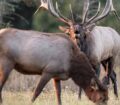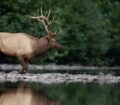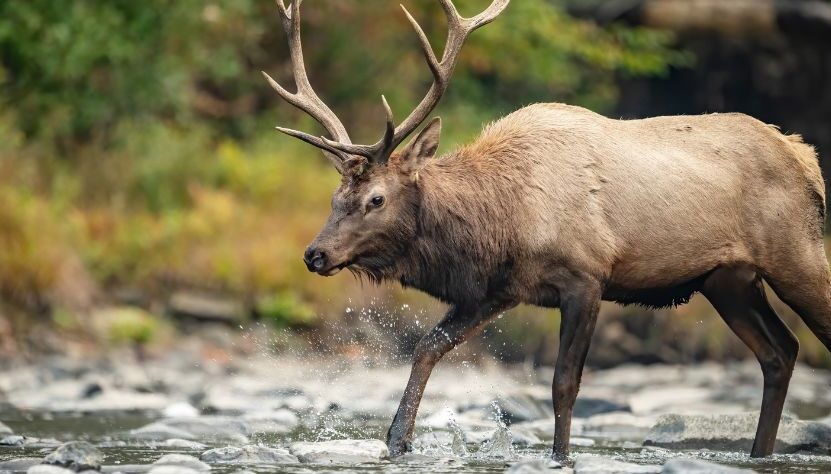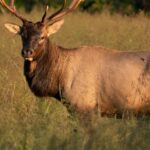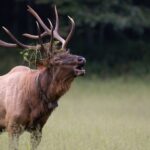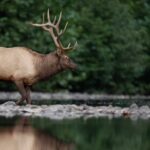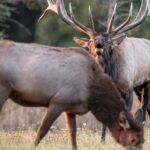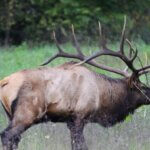Editor’s Note: Longtime, award-winning outdoor writer J. Wayne Fears of New Market, Alabama, has taken 12 bull elk. He’s a nationally known gun writer who has written for most of the gun magazines in the past and today.
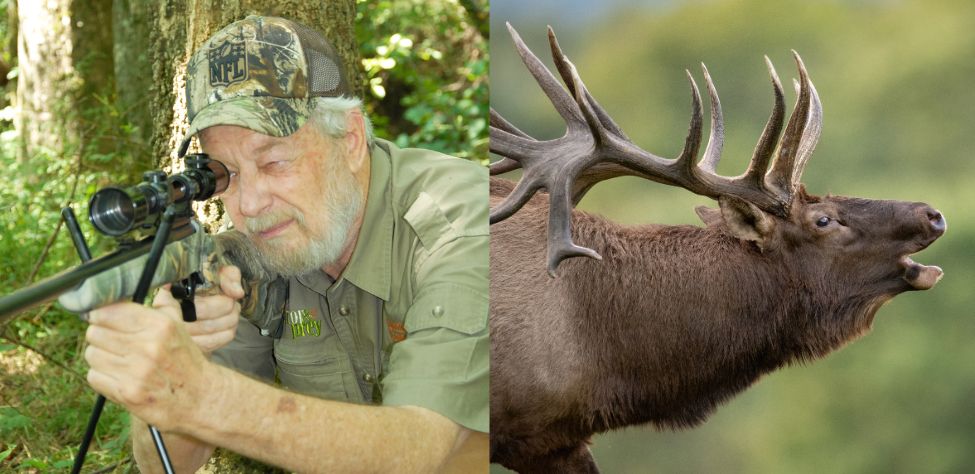
While my guide Daryl was talking to the bull and his herd on this Colorado elk hunt (See Day 1), the herd started climbing up a creek bottom pretty much straight down. In other words, we were on the top of a cliff, looking straight down at the elk about 250 yards away at the bottom.
Our guide, Daryl, said, “We need to see if we can get around this mountain to be ahead of the elk. Then, hopefully, you’ll have a better shot in a better place to get the elk out.” Having a good idea of what you will do to get your elk out when you harvest one is important, but it also helps to shortcut the suffering that can come when you carry an elk’s meat and the head out.
We started walking parallel to the top of the canyon to the elk as they walked up from the bottom. We found a break in the timber where I would have three or four elk-length openings and, hopefully, should be able to get a shot. “Do you think you can make the shot from here?” Daryl asked me. “If I can move down the side of this canyon where I can anchor my butt to the side of this mountain and set up my shooting sticks, I’m pretty sure I can make the shot,” I told Daryl.
Another suggestion I’d make to someone going on an elk hunt is that shooting sticks are worth their weight in gold if you’re hunting elk in the mountains. Often, you won’t set up to shoot where you have a good solid rest. With shooting sticks, you’ll have a rock-solid rest that you’ll need to get an accurate shot. My shooting sticks function as walking sticks, too. When moving up and down mountains, having a third leg helps you stabilize your body much better and allows you to move through steep terrain more safely.
I don’t mind admitting that I’m afraid of heights. As Daryl and I began to climb down this really steep mountain and finally sat down, which was also difficult because the mountain was almost straight up and down, I anchored my heels into the rocks below my feet. I adjusted my shooting sticks to anchor my rifle to them. The cows came through the three openings I could shoot through, and I could see the bulls behind them. I kept hoping they would stop and give me a shot. Just as the bull walked into one of the openings where I could take the shot, Daryl made a cow call, and the bull stopped and just looked up at us. I already had my crosshairs on his shoulder, and I squeezed my trigger. At the report of the rifle, the bull dropped. Daryl ranged the shot that I took at 300 yards.
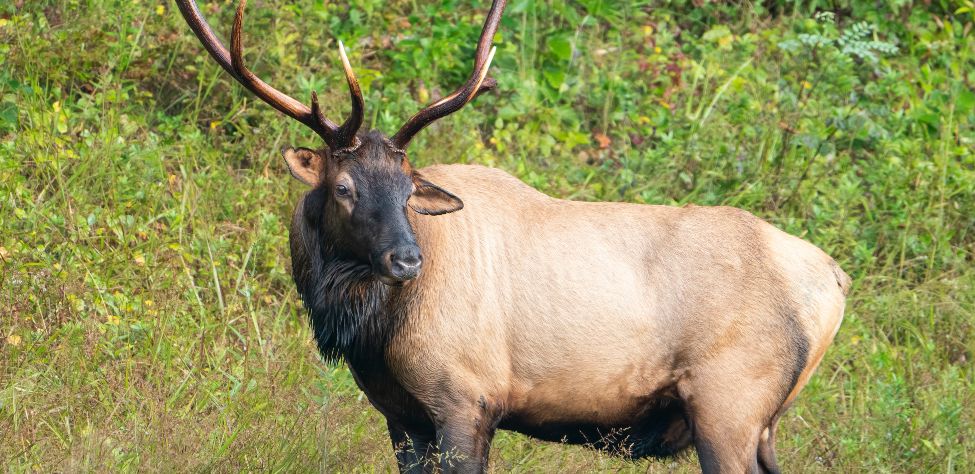
Although this elk hunt had been fun and productive, I knew that the next part of the hunt would be full-out hard work to get the meat and the head out of that canyon. We went down to the bottom of the canyon, picked up two pack mules that a wrangler had brought up for us, and took them up to where the elk was downed. We began much work butchering, quartering, and deboning the meat to get it out on the pack mules.
I’m always asked, “How long have you been using shooting sticks, and what brand of shooting sticks do you use?” I started using shooting sticks in the late 1980s when I learned I could shoot much more accurately with them than if I didn’t use them. I make my shooting sticks from two 3/4-inch wooden dowel rods I buy at Walmart. I put them together with a swivel so that I can close them up or spread them out. I sharpen the bottom ends of my dowels to a point so they’ll dig into the dirt. Then, I can use them as walking sticks and/or to steady my rifle. The reason I like wooden dowels is that they’re really strong and make very stable walking sticks. They’re slightly longer than 3 feet, but when you fold them out, you can adjust them to the terrain where you’ll take the shot. Those shooting sticks have helped me a lot because the older I’ve become, the more essential walking sticks are when hunting at elevations.
Looking for more content? Check out our YouTube channel and watch “A 0-Turn with the Oggun Tractor” by John E. Phillips.
Expert Guidebooks on Elk Hunting: Best Sellers

Secrets for Hunting Elk
The quickest, easiest (if there is an easy way), and safest way to find and take that bull elk of a lifetime will be to hunt with a guide.
Chad Schearer, a longtime Montana guide and TV personality, told me, “My hunter is my gun. If I get to the elk, and my hunter isn’t with me, then we don’t take the elk. My job is not only to find the elk but also to help the hunter get to the elk and make the experience as enjoyable as I can for him.” That’s the kind of fella with whom I want to go elk hunting.
An elk hunt can be tough, but it doesn’t have to be so tough that you don’t enjoy it. That’s why this elk hunting book starts with the confessions of an elk guide and with Chad Schearer’s philosophy of what the guide and the hunter’s relationship should be.
A good portion of your success will depend on your physical condition, and Matt Morrett of Harrisburg, Pennsylvania explains how an eastern hunter can get ready physically during June and July to hunt western elk, the animals he describes as, “Like deer or turkeys on steroids.”
Wayne Carlton, well-known elk hunter and TV and video personality from Montrose, Colorado, tells us what types of elk calls to use and what to say to the elk. Mike Miller of Colorado, another elk guide and Mossy Oak video personality, has tactics for the best equipment for bowhunting and gun hunting elk.
You’ll learn helpful strategies and hunting tips in this book, as well as some straightforward hunting methods that will help to make your elk hunt more successful.
“Thanks to the advice in your elk hunting books, I was able to call up a nice 6-point (6X6) bull elk! He was bugling like crazy. I called him in from about a ¼ mile away. Called him into bow range (about 40 yards away). It was a thrill!” ~Rob Brannon
VERSIONS: AUDIBLE & KINDLE

Elk: Keys to 25 Hunters’ Success
Often just one tip or tactic makes the difference in whether you take an elk home to dinner or have to hike back to the truck by yourself. In John E. Phillips’ latest elk book, Elk: Keys to 25 Hunters’ Success, you’ll learn from successful elk hunters the strategies they use to find and take elk.
Many know that the technique that seems to work most often is to hunt where other elk hunters don’t and understand where the elk are before you go on a hunt by studying data from each state, visiting HuntData (see chapter 1), examining maps, and reading postings on elk forums.
This book also tells you how to get ready physically for an elk hunt, including participating in Train to Hunt Competitions, what gear you need to take, how to enjoy a successful do-it-yourself elk hunt, or how to pick the best elk guide for you. You’ll also hear about the X System and the Broken Y System of hunting elk.
Although no one person has all the answers on how to help you find and take your elk, I’m convinced that this book’s outdoors men and women will teach you how to have satisfying elk hunts.
As my friend Karl Badger once told me, “Elk hunting doesn’t get any better than when I ride horses into the high backcountry, see two grizzly bears, hear a pack of wolves howl close to camp all night long, eat plenty of delicious food prepared on a fire and enjoy the company of good friends.”
VERSIONS: AUDIBLE, KINDLE & PRINT

How to Find Your Elk and Get Him in Close will teach you the tactics of 10 nationally known elk hunters, to help put that giant bull that’s been screaming at you from afar, in your lap. You’ll learn what some of the best guides, outfitters, and successful elk hunters do to find elk and get them in really close.
Also in this audiobook, you’ll notice that the majority of the experts call elk to within bow range. We selected numerous bowhunters and bowhunting guides, since the bowhunter has to get much closer to a bull than the gun hunter does – often less than 20 or 30 yards – practically in your lap.
On one elk hunt, I’d heard this bull bugle all morning. My guide had called him within 30 yards, and he was standing just inside black timber. I saw the smoke from his nose wafting out into the icy air less than 30-yards away. All the bull had to do was step out, and I could take the shot with my bow. But then, through no fault of my guide or me, the bull vanished.
The only conclusion I could come up with to understand why the bull I wanted to take with my bow hadn’t stepped out and given me a shot, was because he got raptured. He evidently had left the earth with no trace of himself.
This hunt was when I started wanting to learn more about hunting elk up close. In this book, I’ve tried to find some of the most knowledgeable, experienced, and practical elk hunters. I’ve always found that the best way to learn any outdoor skill, is to either hunt or fish with the best sportsmen in that field.
Often, in elk hunting, that means elk guides, who generally hunt every day of the season and receive a salary for every hunter they guide. So, I’ve put together a group of some of the best elk hunters I know to help us all learn how to find bull elk and get them in close.
VERSIONS: AUDIBLE, KINDLE & PRINT
Tomorrow: Understand the Best Elk Hunting Calibers

